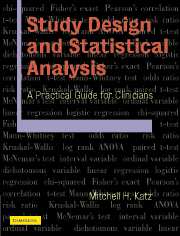Book contents
- Frontmatter
- Contents
- Preface
- 1 Introduction
- 2 Designing a study
- 3 Data management
- 4 Univariate statistics
- 5 Bivariate statistics
- 6 Multivariable statistics
- 7 Sample size calculations
- 8 Studies of diagnostic and prognostic tests (predictive studies)
- 9 Statistics and causality
- 10 Special topics
- 11 Publishing research
- 12 Conclusion
- Index
4 - Univariate statistics
Published online by Cambridge University Press: 05 August 2012
- Frontmatter
- Contents
- Preface
- 1 Introduction
- 2 Designing a study
- 3 Data management
- 4 Univariate statistics
- 5 Bivariate statistics
- 6 Multivariable statistics
- 7 Sample size calculations
- 8 Studies of diagnostic and prognostic tests (predictive studies)
- 9 Statistics and causality
- 10 Special topics
- 11 Publishing research
- 12 Conclusion
- Index
Summary
How should I describe my data?
The analysis of every study, whether a multimillion dollar multicenter randomized controlled trial of 100,000 patients or a descriptive study of one clinician's experience with 40 patients, should begin in the same way: with a review of the distribution of your variables. This is done using graphing techniques and univariate statistics.
You will sometimes see the term “univariate” used to refer to statistics that assess the relationship of two variables to each other. But since “uni” means one, it is preferable to reserve the term for analysis of a single variable and use bivariate analysis (Chapter 5) to refer to the relationship between two variables.
How should I describe my interval and ordinal variables?
The first Step in describing interval and ordinal variables is to visually review their distribution. This is done using a histogram.
Figure 4.1 shows a histogram of the estimated glomerular filtration rate (GFR) of 14,527 patients.
Note that on a histogram each interval of a variable is represented as a rectangle sitting on a line (the line is usually horizontal, but histograms can also be shown on a vertical line); the line shows the range of possible values for the variable. The height of each rectangle indicates the frequency of the response (number of subjects or percentage of sample). Each rectangle is placed on the line at the center of the response (i.e., a rectangle representing 68–72 ml/min/1.73m2 of GFR would be positioned on the axis at 70 ml/min/1.73m2, the midpoint of the interval).
Information
- Type
- Chapter
- Information
- Study Design and Statistical AnalysisA Practical Guide for Clinicians, pp. 52 - 65Publisher: Cambridge University PressPrint publication year: 2006
Accessibility standard: Unknown
Why this information is here
This section outlines the accessibility features of this content - including support for screen readers, full keyboard navigation and high-contrast display options. This may not be relevant for you.Accessibility Information
- 1
- Cited by
